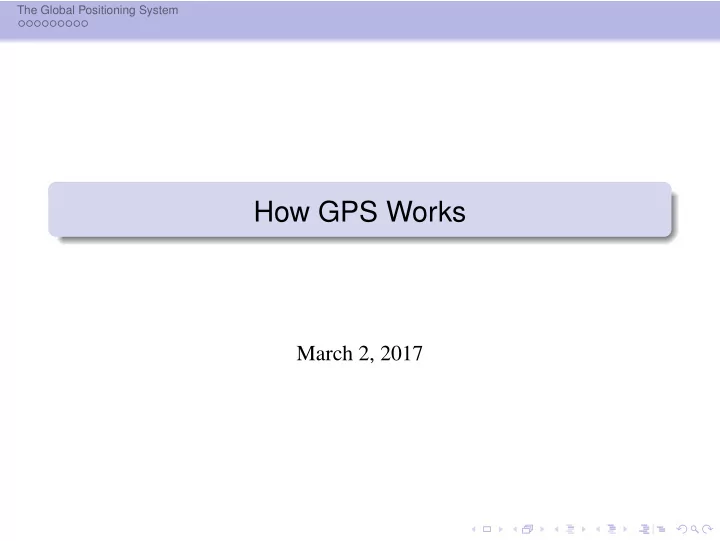

The Global Positioning System How GPS Works March 2, 2017
The Global Positioning System Outline The Global Positioning System 1 Problem Data Distance System of equations Solution
The Global Positioning System Image from aero.org: www.aero.org/education/primers/gps/images/5steps-illustration.jpg
The Global Positioning System The problem How does the GPS determine the location of the receiver at a particular point in time? • We have the position and time from each of four satellites. • We need to find the position of the GPS receiver. • We know that the signal travels at the speed of light: about 0.47 Earth radii per hundredth of a second.
The Global Positioning System The unit circle Locations are given using the x , y , z coordinate system. • The Earth is a unit sphere, centred at the origin. • Points on the surface of the earth satisfy the equation x 2 + y 2 + z 2 = 1. http://resources.esri.com/help/9.3/ArcGISEngine/dotnet/bitmaps/b0e91ce8-c180-47dc-8323-06cac5d770641.png
The Global Positioning System Satellite data Satellite Position Time ( 1 . 11 , 2 . 55 , 2 . 14 ) 1 1 . 29 ( 2 . 87 , 0 . 00 , 1 . 43 ) 2 1 . 31 3 ( 0 . 00 , 1 . 08 , 2 . 29 ) 2 . 75 4 ( 1 . 54 , 1 . 01 , 1 . 23 ) 4 . 06
The Global Positioning System Distance The signal from Satellite 1 was sent at time 1.29, and received at time t . (We do not assume that we know t with enough accuracy.) Thus the time it travelled was t − 1 . 29 hundredths of a second. The distance it travelled is: d = 0 . 47 ( t − 1 . 29 ) Earth radii .
The Global Positioning System Equating distances The distance can also be computed using the distance formula: the distance between the point ( 1 . 11 , 2 . 55 , 2 . 14 ) and the point ( x , y , z ) is � ( x − 1 . 11 ) 2 + ( y − 2 . 55 ) 2 + ( z − 2 . 14 ) 2 . d = Since this must equal the distance we calculated using the time, we have � ( x − 1 . 11 ) 2 + ( y − 2 . 55 ) 2 + ( z − 2 . 14 ) 2 = 0 . 47 ( t − 1 . 29 ) .
The Global Positioning System Simplify Square both sides and simplify to get: 2 . 22 x + 5 . 10 y + 4 . 28 z − 0 . 57 t = x 2 + y 2 + z 2 − 0 . 22 t 2 + 11 . 95 . Similarly, we can get equations for satellites 2, 3, 4: + 2 . 86 z − 0 . 58 t = x 2 + y 2 + z 2 − 0 . 22 t 2 + 9 . 90 5 . 74 x + 2 . 16 y + 4 . 58 z − 1 . 21 t = x 2 + y 2 + z 2 − 0 . 22 t 2 + 4 . 74 3 . 08 x + 2 . 02 y + 2 . 46 z − 1 . 79 t = x 2 + y 2 + z 2 − 0 . 22 t 2 + 1 . 26
The Global Positioning System Linear? At this point, we have a system of equations, but they are not linear equations. However, we can simplify to a linear system by subtracting.
The Global Positioning System System of equations = 3 . 52 x 5 . 10 y 1 . 42 z 0 . 01 t 2 . 05 − − − + = − 2 . 22 x 2 . 94 y 0 . 30 z 0 . 64 t 7 . 21 − − = 0 . 86 x 3 . 08 y 1 . 82 z 1 . 22 t − 10 . 69 − − − This can be solved by substitution, elimination, or matrix methods. 3 . 52 − 5 . 10 − 1 . 42 − 0 . 01 2 . 05 1 0 0 0 . 36 2 . 97 − 2 . 22 − 2 . 94 0 . 30 − 0 . 64 7 . 21 − 0 1 0 0 . 03 0 . 81 → 0 . 86 − 3 . 08 − 1 . 82 − 1 . 22 − 10 . 69 0 0 1 0 . 79 5 . 91
The Global Positioning System Solution x = 2 . 97 0 . 36 t − = y 0 . 81 0 . 03 t − = z 5 . 91 0 . 70 t − Putting this back into the original first equation gives 0 . 54 t 2 − 6 . 65 t + 20 . 32 = 0 with solutions t = 6 . 74 and t = 5 . 60, so ( x , y , z ) = ( 0 . 55 , 0 . 61 , 0 . 56 ) or ( x , y , z ) = ( 0 . 96 , 0 . 65 , 1 . 46 . The second solution is not on the unit sphere; the first one is. This is then converted into latitude and longitude, but we’ll save that for another day!
Appendix References I D. Kalman An underdetermined linear system for GPS The College Mathematics Journal , 33 (2002), 384–390. D. Poole Linear Algebra, a Modern Introduction , Ed. 4, Cengage Learning, 2015. G. Strang and K. Borre Linear Algebra, Geodesy, and GPS , Wellesley-Cambridge Press, 1997.
Recommend
More recommend